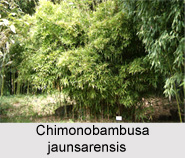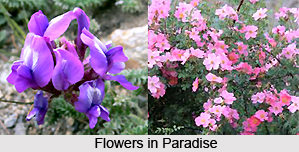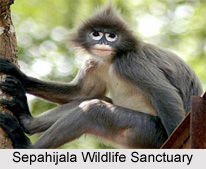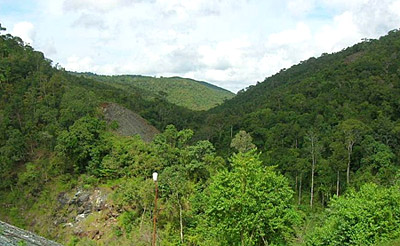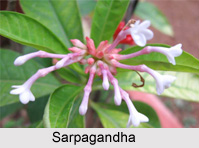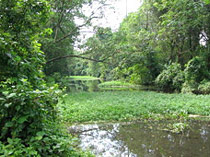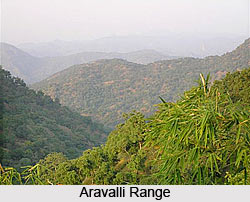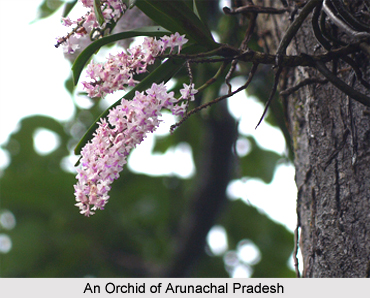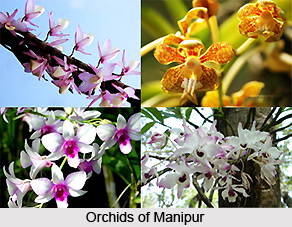 Tholkappia Poonga, also known as Adyar Eco Park or Adyar Poonga, is an ecological park situated in the Adyar estuary area of Chennai, Tamil Nadu. It has been established by the Government of Tamil Nadu with the aim of restoration of freshwater ecosystems and vegetation of Coromandel Coast, especially that of Adyar estuary and creek. Spanning over a vast stretch of land, it mainly comprises tropical dense evergreen forest with 160 species of woody plants and six vegetative varieties such as tuberous, herbs, epiphytes, lianas, shrubs and trees. Tholkappia Poonga has been named after Tholkappiar, the renowned Tamil scholar. It was inaugurated on 22 January 2011 by Chief Minister M. Karunanidhi. It forms an ideal place to study about water management, eco-restoration and wetland conservation.
Tholkappia Poonga, also known as Adyar Eco Park or Adyar Poonga, is an ecological park situated in the Adyar estuary area of Chennai, Tamil Nadu. It has been established by the Government of Tamil Nadu with the aim of restoration of freshwater ecosystems and vegetation of Coromandel Coast, especially that of Adyar estuary and creek. Spanning over a vast stretch of land, it mainly comprises tropical dense evergreen forest with 160 species of woody plants and six vegetative varieties such as tuberous, herbs, epiphytes, lianas, shrubs and trees. Tholkappia Poonga has been named after Tholkappiar, the renowned Tamil scholar. It was inaugurated on 22 January 2011 by Chief Minister M. Karunanidhi. It forms an ideal place to study about water management, eco-restoration and wetland conservation.
Fauna of Tholkappia Poonga
Initially Tholkappia Poonga had recorded 200 species of birds in the creek area. However many of them have vanished owing to rapid urbanization. The common species of birds spotted in the Eco Park include black-winged stilt, Chestnut-winged Cuckoo, Egret, Yellow Wagtails, Yellow Wagtails, Pied Kingfisher, White-Bellied Sea Eagle, Cinnamon Bittern and many others.
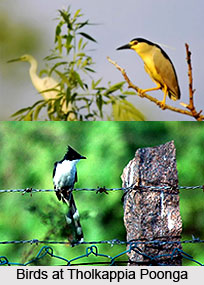 Apart from these, 143 species of fishes, reptiles, birds and amphibians can be witnessed in the park. Butterflies of the park include Blue-Tailed Green Darner Dragon Fly, Black Rajah, Rare Painted Lady etc. Green pond frogs, painted frogs, soft and hard shell turtles and non poisonous snakes are also the residents of Tholkappia Poonga. After the restoration work in the region, the water quality has improved substantially and has been stated to be suitable for wildlife propagation by Central Pollution Control Board. Other species of fauna found in the Eco Park enlist amphibians like Flapshell Turtle and Skipper Frog, reptiles like Saw-Scaled Viper and Common Indian Bronzeback, mammals such as Indian Flying Fox and Grey Mongoose and fishes like Flathead Mullet and Indian Shortfin Eel. Tholkappia Poonga has in all identified 30 species of fish, 20 different dragonflies, 56 species of butterflies, 25 species of reptiles and amphibians, 90 species of birds and 10 species of mammals.
Apart from these, 143 species of fishes, reptiles, birds and amphibians can be witnessed in the park. Butterflies of the park include Blue-Tailed Green Darner Dragon Fly, Black Rajah, Rare Painted Lady etc. Green pond frogs, painted frogs, soft and hard shell turtles and non poisonous snakes are also the residents of Tholkappia Poonga. After the restoration work in the region, the water quality has improved substantially and has been stated to be suitable for wildlife propagation by Central Pollution Control Board. Other species of fauna found in the Eco Park enlist amphibians like Flapshell Turtle and Skipper Frog, reptiles like Saw-Scaled Viper and Common Indian Bronzeback, mammals such as Indian Flying Fox and Grey Mongoose and fishes like Flathead Mullet and Indian Shortfin Eel. Tholkappia Poonga has in all identified 30 species of fish, 20 different dragonflies, 56 species of butterflies, 25 species of reptiles and amphibians, 90 species of birds and 10 species of mammals.
Other Features of Tholkappia Poonga
Adyar estuary covers an area of about 300 acres and is characterized by calm conditions, low salinity and high plankton availability in the creek. This makes it a good nursery for fish. Boating is quite easy owing to tidal flow of water in and out of the creek. The activity of fishing is much flourished here and a prosperous economy of fish trade was prevalent. For a certain period however the biological activities in the region was affected due to the disposal of city`s sewage and industrial effluents into the river. Tholkappia Poonga also serves as an important site for migratory birds which feed on the coastal mudflats. It also has an organization called `Friends of Adyar Poonga` which has been set up with the purpose of promoting environment conservation. It also aims at creating environmental awareness in local schools. On every second Saturday of the month, the members of the organization assemble in the park.
